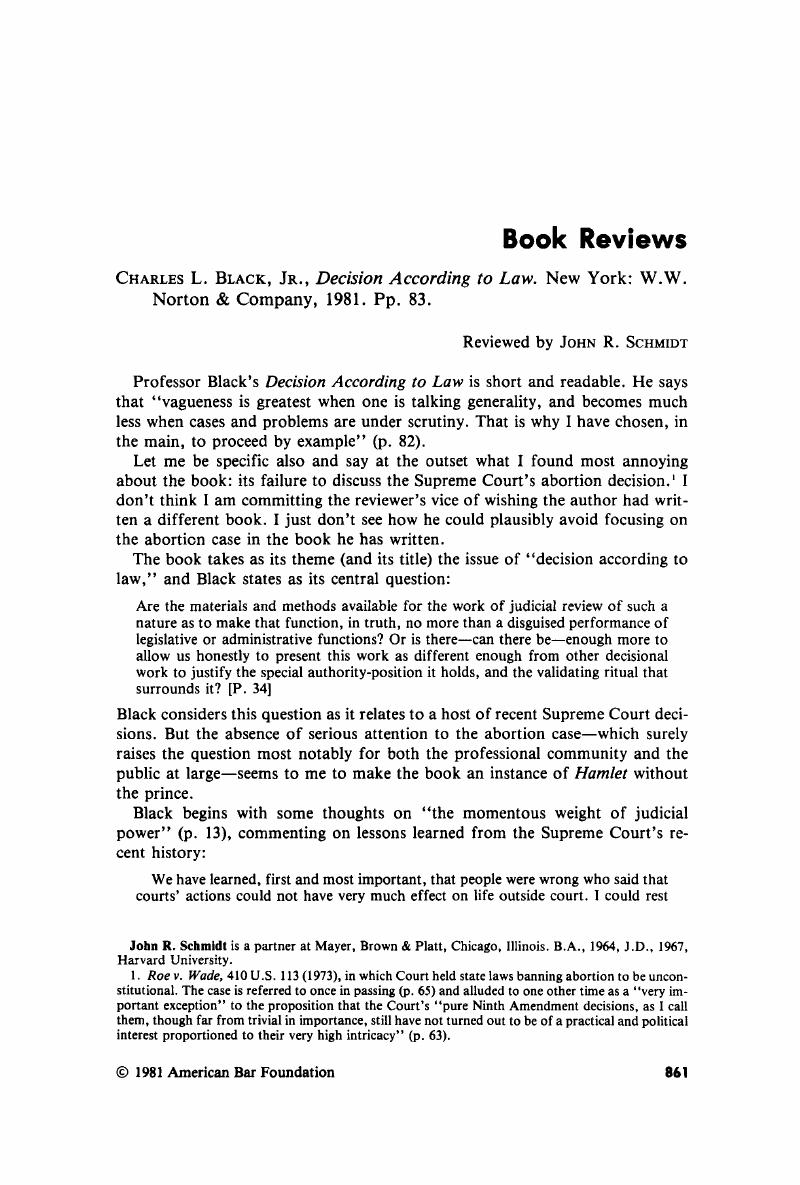No CrossRef data available.
Article contents
Charles L. BlackJr. , Decision According to Law. New York: W.W. Norton & Company, 1981. Pp. 83.
Published online by Cambridge University Press: 20 November 2018
Abstract

- Type
- Book Reviews
- Information
- Copyright
- Copyright © American Bar Foundation, 1981
References
1 Roe v. Wade, 410 U.S. 113 (1973), in which Court held state laws banning abortion to be unconstitutional. The case is referred to once in passing (p. 65) and alluded to one other time as a “very important exception” to the proposition that the Court's “pure Ninth Amendment decisions, as I call them, though far from trivial in importance, still have not turned out to be of a practical and political interest proportioned to their very high intricacy” (p. 63).Google Scholar
2 Black says, “The political map of the country was totally redrawn in ten years, quite plainly in consequence of judicial action” (p. 16). This is true in the sense that the court decisions have resulted in redrawing a lot of district boundaries, and continuing to redraw them every ten years in what has become a decennial pitched battle in every state legislature. The much harder question is just what the ultimate impact of all this reapportionment has been and, if one could identify it, whether that impact has been positive. For example, is there any reason to believe that the state legislatures, in which both houses must now have equally apportioned districts, are providing any better (or any very different) representation than the U.S. Congress, in which one house (the Senate) continues to be severely mal-apportioned in terms of population? One can only speculate, and not do that with much confidence. The contrast to the desegregation cases—where both the fact of the impact and its positive character are clear—seems to me striking.Google Scholar
3 An exception to this generalization might be the Court's decisions in the obscenity area, but the widespread proliferation of pornography is probably a “social revolution” most members of the Court would prefer to disavow. Those who would defend the Court's decisions would say that these social consequences are a price we must pay for the protection of the First Amendment rights generally; they are not a result the Court has set out to accomplish.Google Scholar
4 As a test of the hypothesis that the racial segregation cases may be unique, consider what the consequences might be today if the Court were to attempt to achieve some major social change in a different area—say, on the matter of the position of homosexuals in our society, starting out with a decision (following the old cases outlawing antimiscegenation laws) holding unconstitutional state laws which do not allow the marriage of two members of the same sex. Or look at the Court's caution in dealing with the whole matter of sex discrimination.Google Scholar
5 That proposal would express a congressional view that “life” begins at the moment of conception. It would also deny the federal district courts any jurisdiction over abortion cases and make such cases an “exception” to the Supreme Court's appellate jurisdiction from the state courts.Google Scholar
6 See Hart, Henry M. Jr., The Power of Congress to Limit the Jurisdiction of Federal Courts: An Exercise in Dialectic, 66 Harv. L. Rev. 1362, 1365 (1953).Google Scholar
7 These italics are all in the original—an annoying trait in what is generally a very elegant style.Google Scholar
8 Black argues that the Court's invalidation of certain federal law discriminations against women does not raise a real issue of judicial conflict with the judgment of a democratic legislature because Congress has proposed the Equal Rights Amendment, embodying a judgment against sex discrimination, for adoption by the states. (See pp. 74–75.) This strikes me as absurd. It takes a proposed amendment—and surely senators and representatives know as much as anybody about how far that may be from effective ratification—and regards it as better evidence of congressional judgment than an enacted statute.Google Scholar
9 He wrote:Google Scholar
Experience suggests that in fact there will be a systematic bias in judicial choice of fundamental values, unsurprisingly in favor of the values of the upper-middle, professional class from which most lawyers and judges, and for that matter most moral philosophers, are drawn. People understandably think that what is important to them is what is important, and people like us are no exception. Thus, the list of values the Court and the commentators have tended to enshrine as fundamental is a list with which readers of this book will have little trouble identifying: expression, association, education, academic freedom, the privacy of the home, personal autonomy, even the right not to be locked in a stereotypically female sex role and supported by one's husband. But watch most fundamental-rights theorists start edging toward the door when someone mentions jobs, food, or housing: those are important, sure, but they aren't fundamental.Google Scholar
John Hart Ely, Democracy and Distrust: A Theory of Judicial Review 58–59 (Cambridge, Mass.: Harvard University Press, 1980) (footnotes omitted).Google Scholar


